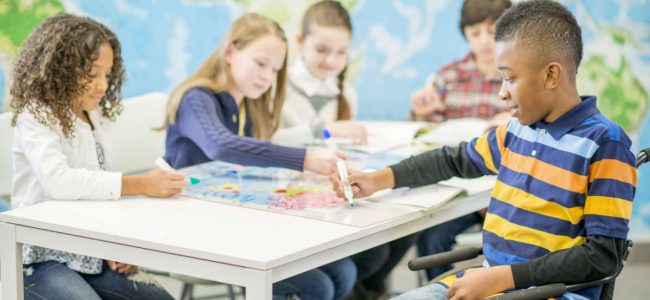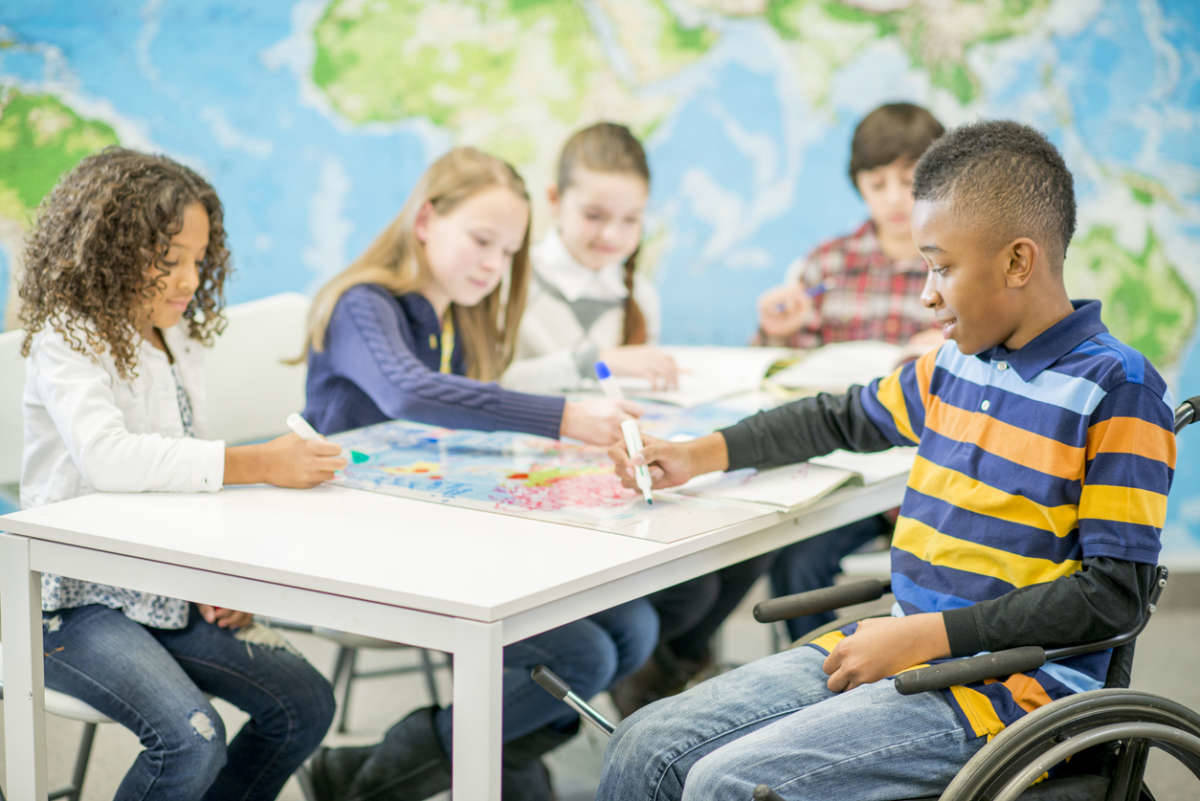
In today’s increasingly diverse educational landscape, the role of inclusive education has become paramount. Actually, Inclusive education seeks to develop a learning environment where all students, regardless of their individual differences, are welcomed, valued, and supported to expand their full potential.
As you may know, This article explores the multifaceted aspects of inclusive education, highlighting its benefits, challenges, and strategies for implementation in diverse classrooms.
By embracing inclusive practices, educators can cultivate a classroom environment that celebrates diversity, promotes equity, and empowers all learners to thrive. This article delves into the essential components inclusive education, providing practical insights and evidence-based strategies to guide educators in creating classrooms where every student feels valued and has the opportunity toofsucceed.
Understanding Inclusive Education
Actually, Inclusive education from another perspective is an educational approach that aims to provide equal access and opportunities for all students, regardless of their individual differences, abilities, or disabilities. It’s worth noting that It is based on the principle that every student has the right to a caliber education and that all students can learn and succeed in a supportive and inclusive environment.
Actually, Inclusive education offers numerous benefits for all students, including:
- Improved academic outcomes for all students, including students with disabilities
- Increased social and emotional development for all students
- Reduced stigma and discrimination against students with disabilities
- A more positive and welcoming school climate for all
There are many examples of successful inclusive education practices, including:
- Co-teaching, where two teachers with different areas of expertise work together to provide instruction in the same classroom
- Universal Design for Learning (UDL), which involves creating learning materials and environments that are accessible to all students, regardless of their individual needs
- Assistive technology, which can help students with disabilities to access the curriculum and participate fully in the classroom
Addressing more than ever Diversity in Classrooms
Classrooms today are , diverse than ever before, with students from a wide range of backgrounds, culturesmoreabilities, and learning styles. This diversity can be a source of great strength for a classroomteachersbut it as it turns out can also present challenges for , .
By understanding the dimensions of diversity and the challenges andvariousopportunities they present, teachers can generate a welcoming and supportive learning environment for all students.
Identifying the Dimensions of Diversity
The dimensions of diversity in classrooms can be categorized into two broad groups: visibleand invisibleVisible dimensions of diversity include race, ethnicity, gender, physical appearance, and socioeconomic status. These dimensions are often readily apparent and can be used to build stereotypes and assumptions about students. .
Invisible dimensions of diversity include learning styles, personality traits, cultural values, and beliefs. Indeed, These dimensions are not as easily observable, but they can have a significant impact on how students learn and interact with others. For sample, students from different cultures may have different communication styles or learning preferences.
Challenges and Opportunities of Teaching in Diverse Classrooms
Teaching in diverse classrooms can be both challengingrewardingand . One of the biggest challenges is meeting the needs of all , who may havestudentsdifferent learning styles, interests, and backgrounds. meet can require teachers to utilize a variety of teaching methods and to differentiate instruction to This the needs of individual students.
As you may know, By exposing students to different cultures and perspectives, teachers can assist them to develop tolerance, understanding, and empathy. In addition, diverse classrooms can be a source of creativity and innovation, as students from different backgrounds bring different ideas and experiences to the learning process. However, teaching in diverse classrooms also presents many opportunities.
As you may know, Strategies for Creating a Welcoming and Supportive Learning Environment
There are a number of strategies that teachers can use to build a welcoming and supportive learning environmentregardlessfor all students, of their background or abilities. These as a matter of fact strategies include:
- Getting to know your students.The first step to creating a welcoming and supportive learning environment is to get to know your students. This includes learning about their backgrounds, interests, and learning styles.
- Setting clear expectations.All students need to know what is expected of them in order to be successful. Teachers should set clear expectations for behavior, academic performance, and participation.
- Creating a positive classroom culture.A positive classroom culture is one in which all students feel respected, valued, and supported. Teachers can create a positive classroom culture by being fair, consistent, and encouraging.
- Providing opportunities for students to succeed.All students need to have opportunities to succeed in order to develop their confidence and self-esteem. Teachers can provide opportunities for students to succeed by providing differentiated instruction, scaffolding learning, and offering extra support.
- Celebrating diversity.Diversity is a strength, not a weakness. Teachers should celebrate diversity in their classrooms by recognizing and valuing the different cultures, backgrounds, and perspectives of their students.
By implementing these strategiesstudentsteachers can develop a welcoming and supportive learning environment for all , , regardless of their background or abilities. This will support students to . their full potential and to become successful learnersspread
Development Qualified and Aid

Effective skilled development programs for inclusive: education provide opportunities for teachers to Expert development is essential for teachers in inclusive education to develop the knowledge, skills, and attitudes necessary to effectively meet the diverse needs of all students.
- Learn about inclusive practices and strategies
- Develop lesson plans and activities that are accessible to all learners
- Create a positive and supportive learning environment
li>Collaborate with other professionals to aid students with disabilities
Role of Administrators and School Leaders
Administrators and school leaders play a vital role in supporting teachers in implementinginclusive practices. They: can do this by
- Providing professional development opportunities for teachers
- Creating a school culture that is inclusive of all students
- Supporting teachers in developing and implementing individualized education programs (IEPs) for students with disabilities
- Providing resources and materials to support inclusive practices
Educational Policies and in modern times Practices
Educational policies playa critical role in shaping the implementation of inclusive education. can They either aid or hinder the creation of inclusive learning environments.
It’s worthonnoting that Impact of Educational Policies Inclusive Education
Educational policies . impact inclusive education in various wayscan For instance, policies as it turns out that mandate of inclusion the students with disabilities in mainstream classrooms can promote their access to education. However, policies that emphasize standardized testing and accountability may develop barriers for students with diverse learning needs.
Role of Advocacy in Promoting Inclusive Practices
for, Advocacy is crucial Actually promoting inclusive practices. It involves raising awareness about the importance of inclusion, challenging discriminatory policies, and advocating for changes that help inclusive education. Advocacy efforts can be carried out by parents, educators, disability rights organizations, and policymakers.
In fact, Innovative Educational Practices that Promote Equity and Inclusion
Theseincludepractices : Innovative educational practices can significantly contribute to equity and inclusion in classrooms.
Universal Design for Learning (UDL)
Indeed, UDL is a framework for creating learning environments that are accessible to all students, regardless of their abilities or learning styles.
Differentiated Instruction
In fact, Differentiated instruction involves tailoring instruction to meet the individual needs of students, ensuring that all students have access to meaningful learning experiences.
Cooperative Learning
Cooperative learning strategies encourage studentsandto work together in small groups, fostering collaboration, communication, mutual support.
Assistive Technology
Assistivewithtechnology tools, such as screen readers and speech-to-text software, can provide students disabilities access to educational text and participation in classroom activities.
Education Research and Evidence
Research plays a crucial role in informing and advancing inclusive education practices. provides valuable insights into effective strategies, challenges, and theItimpact of inclusive education as a matter of fact on students and educators.
Findings ofRecent Research
Recent research has demonstrated the positive benefits of inclusive.education, including improved academic outcomes, increased social and emotional development, and enhanced self-esteem for students with as it turns out disabilities Studies have also highlighted the need for ongoing expert development, collaboration among educators, and supportive educational policies to ensure the successful implementation of inclusive practices.
Areas for Further Research
While significant progress has been made, further research is needed to advance the input of inclusive education. Key investigation for ahead areas include:
- Long-term outcomes of inclusive education for students with disabilities
- Effective strategies for supporting students with diverse learning needs in inclusive settings
- The role of technology in promoting inclusivity and accessibility
- The impact of inclusive education on the school climate and culture
Conclusion
conclusion, the role of inclusive education in diverse classroomsInis indispensable. By understanding the principles of inclusion, addressing the challenges of diversity, and implementing effective strategies, educators can develop more than ever learning environments that are welcoming, supportive, and equitable for all students.
As you may know, Inclusive education is not merely a pedagogical approach; it is a fundamental commitment to ensuring that every learner has the opportunity to spread their full potential and contribute meaningfully to society. As we continue to strive for educational equity and inclusion, let us embrace the transformative power of inclusive education and work together to generate classrooms where all students can flourish.
FAQ in modern times Explained
What are the key principles of inclusive education?
It students that all recognizes have the right to access grade education and that their diverse needs should be met. Inclusive education is founded on the principlesaidof equity, respect, and individualized .
How can inclusive education benefit all students?
Inclusive education benefits all students by creating environment supportive and stimulating learning a. It promotes collaboration, empathy, and a sense of belonging, fostering positive social and emotional development.
What are some challenges of teaching in diverse classrooms?
Teaching in range classrooms presents challenges such as accommodating a wide diverse of learning styles, addressing language barriers, and ensuring that as it turns out all students feel valued and included.
How can teachers create a welcoming and supportive learning environment for all students?
Teachers can develop a welcoming and supportive learning environment by using differentiated instruction, providing emotional assistance, and establishing clear expectations and routines.